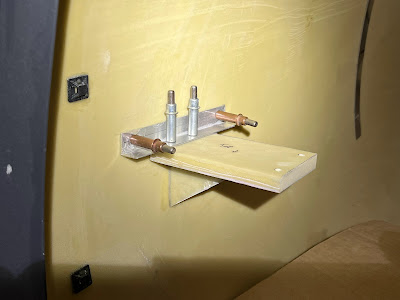I thought the UL ECU wiring would be simple, and in some ways it is simple. But as always, the devil is in the details.
Power: The ECU has 6 wires that all need to be attached to an ECU switch.
Ground: The ECU has 5 wires that go to ground.
FPCR (Fuel Pump Control Relay(s)): The ECU can control the pump(s). I opted to do so, but there is a 2nd bypass circuit around the relays just in case.
Ignition: Circuits for left / right or 1/2 coils to switches (or a standard key switch). Grounded they are OFF, open they are ON - just like a mag.
Aux box: Provides ambient pressure. Plus other things, but this is all I am using it for.
Boost controller: Control line from the ECU to the Boost Controller, plus power and ground.
CAN-bus: Data lines to grab engine data via CAN.
RS-232: Separate RS-232 connection for an EFIS feed, or to use the UL-READ software. I need to order this cable.
Discrete engine inputs: Separate inputs for Engine RPM and fuel consumption. I am not using these, as they are provided over the CAN-bus.
Dummy lights: 2 LED's. 1 for 'check engine' (which indicates a sensor fault), and 1 for 'low battery'. I planned for both of these in the panel. The ECU only provides a ground to activate these LED's, power is separate.
The above is the basic lay of the land.
Current schematic below.
At present, everything is wired except the key switch.
The challenges:
- The ECU is mounted on a tray forward of the instrument panel. If it needs to be removed, take out the MFD, remove the two harnesses, loosen the bolts and its free. You should be able to do all this sitting upright in the seat.
- Making the above happen is a challenge. I had to route all the wires in two consistent bundles (one firewall forward, and one for the cockpit interconnects) and not running in 4 different directions.
- To do so, I fabricated some wiring 'braces' that everything is tie wrapped to. But its all very condensed. Hopefully this works out.
- Everything is wired for the ECU, and it powers up (the LED's flash upon startup).
- The next big step is to see if the ECU connects to the CANBUS on the EMS221.
- The wires are not in their final position. I want to make sure everything works before doing the final tie wraps (hence no pictures, it looks pretty ugly right now)
- Magnetometer: Cable is run, but needs to be shortened (ordered it too long)
- Fuel tank probes. Wires to the EMS, needs to head out to the wings.
- Sticks: Sticks themselves are wired, just need to route them and connectorize from the ACM (plus the pull downs from the audio panel, com, and ACM aircraft rear connector
- RF / antennas: VOR, 2xCOM antennas.






























